To find the maximum number of matches won by a team is very easy, because for a team to have the most wins, it must win all the matches it plays.
In this scenario, the team would play a total of 12 matches before the final.
| Table of contents |

|
| 1. Round Robin |

|
| 2. Knockout Tournaments |

|
| 3. Combination or Hybrid Models |

|
| Key Points |

|
| Summary |

|
- Games and tournaments test your ability to analyse structures like round-robin and knockout formats, often requiring calculations of matches, points, or wins.
- This document provides solved examples to help you tackle such problems systematically, covering key concepts and strategies.
- Let’s get started!

1. Round Robin
Round Robin is a tournament where each team plays with every other team. Suppose there are 8 teams in a tournament, then every team will play seven matches. This is known as a single round robin. When every team plays with every other team exactly once, then it is called a single round robin.
We all know about IPL, right? In IPL, every team plays against every other team twice. This is a double round robin, where each team plays every other team two times. That means, for a tournament of eight teams, each team gets to play 14 matches. The winner (or the rankings) is decided based on all the matches.
A few things to remember regarding the matches:
- The total number of matches for a single round robin is NC2, where N is the total number of teams participating in the tournament.
- If there is no draws, the number of wins is equal to the number of matches. It applies to the number of losses as well.
- In case there are draws, the total number of wins + (total draws/2) = total number of matches.
For instance, in a single round-robin with 4 teams (A, B, C, D), each team plays 3 matches (total matches = 4 choose 2 = 6). If A wins all 3 matches, B wins 2, C wins 1, and D wins 0, the total wins (3 + 2 + 1 + 0 = 6) equal the total matches, assuming no draws.
There are two key points for this type of question:
1. If we are finding the maximum number of points for a team, then start distributing the points from bottom to top.
2. If we are finding the minimum number of points for a team, then start distributing the points from top to bottom.
We will see the above cases in the following example.
Example: There are 16 teams and they are divided into 2 groups of 8 each. Each team in a group plays against one another on a round-robin basis. Two points are awarded for a win, one point for a tie and zero for a loss. The top four teams from each group will qualify for the next round i.e. round 2. In Round 2, each team of one group will play with each team of group two. At the end of the second round, the top four teams in terms of the points scored advance to the semi-finals and the winners of the semi-finals play the finals. In case of teams having the same number of wins, the team with the better run-rate would be ranked ahead.
(Note: Write down all the key points which are mentioned in the questions.
Like,
A total of 16 teams
Two group - Each group having 8 teams.
Points - Win: 2, Tie / Draw: 1, Loss: 0
Top four from each group will go to the next round.(4 Matches)
Semi Finals (2 Matches), Final.)
i) What is the total number of matches played in the tournament?
a) 50
b) 56
c) 28
d) 75
Ans: d) 75
Total matches = Number of group A matches + Number of group B matches + Round 2 + Semi-Finals + Final
= 8C2 + 8C2 + 4C1 x 4C1 + 2 + 1
= 28 + 28 + 16 + 2 + 1 = 75 matches
ii) What is the least number of points with which a team can advance to the round 2?
a) 5
b) 4
c) 10
d) 8
Ans: a) 5
As we have seen in key points that if we are looking for the minimum points, then we will have to go from Top to Bottom.
In the given question, we have to find out the "Least number of points" which means a minimum number of points. SO we will have to start point distribution from Top to Bottom.
Now, let assume that top #1 team won all its 7 matches. (14 Points)
Top #2 team won all its matches except against #1 team. (12 Points)
Top #3 team won all its matches except against #1 and #2 matches. (10 Points)
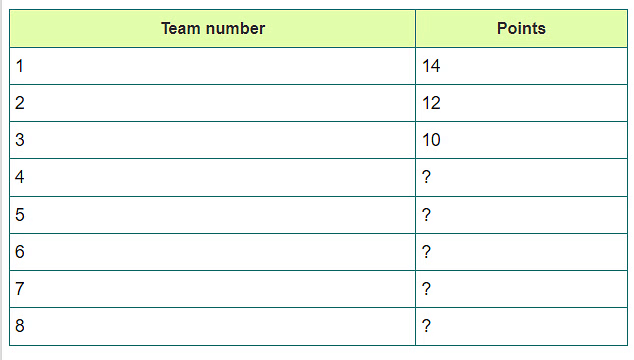
Now we are left with 20 points (i.e. Total points for group one matches 56 - (14 + 12 + 10) = 20).
Now remaining 5 teams have lost 3 matches to the top teams. So, they are left with 4 matches with others. We will distribute the remaining points equally to them, i.e. 20 / 5 = 4.
So, the remaining 5 teams will now have 4 - 4 points and here run rate checking scenario occurs.
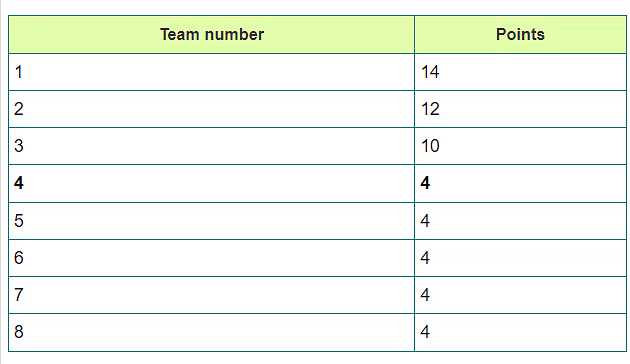 So, a minimum or least 4 Points is required for getting into the second round.
So, a minimum or least 4 Points is required for getting into the second round.
iii) What is the maximum possible number of points that can be scored by a team that is eliminated at the first round?
a) 14
b) 12
c) 10
d) 8
Ans: c) 10
In this case, we have to find out the maximum possible number of points that can be scored by a team which is eliminated after the first round (Simply, by Low run rate)
As we have mentioned in the key points that to find the maximum points, we have to start from the bottom to the top.
We will make a group of the Bottom 3 teams and another of the Top 5 teams.
Let’s assume that the bottom 3 team will lose their matches against the top teams. So, they will have a total of 3 matches left to win. (Those 3 teams will play against each other) Total 6 points they can have. We will distribute those points equally between them. i.e. 2 points for each team.
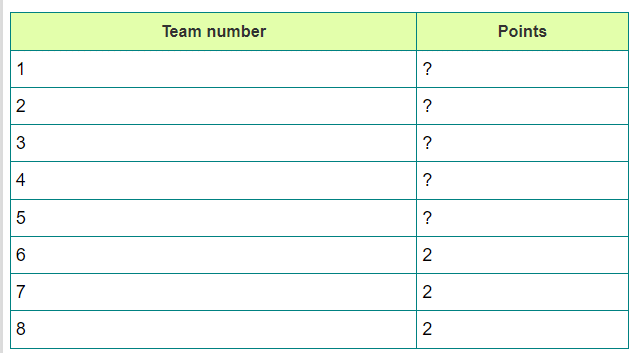
Now, we have to give the top 5 teams equal points so that we can have the top 4 teams advance to the next round, and team #5 gets eliminated after the first round, even though it may have the maximum number of points.
So, the remaining 50 points (i.e., total points 56 - 6 points distributed among the bottom 3 teams = 50 points) will be distributed equally among the 5 teams, which means 10 points each.
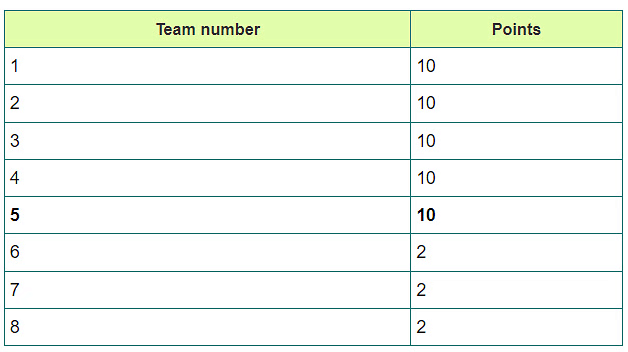
Now, team #5 will also have 10 Points but it will be out of the league because of low run rate. So, answer is 10.
iv) What is the minimum number of matches won by a team that reaches the finals?
a) 1
b) 2
c) 3
d) 4
Ans: a) 1
This is very simple because we can assume that all the matches in every round before the semi-finals are drawn, and a team advances to the semi-finals based on a higher net run rate.
To reach the final, the team only needs to win one match, i.e., the semi-final.
(This is only possible if the question allows for a "Draw/Tie" scenario.)
So, the answer is 1.
v) What is the maximum number of matches won by a team that reaches the finals?
a) 10
b) 16
c) 15
d) 12
Ans: d) 12
In first round, 7 Matches (Match with each team in the group.)
In second round, 4 matches (Match with each team of another group which enters in second round.)
In Semi-Final, one match.
So, Total 7 + 4 + 1 = 12 Matches, a team has to win to reach in finals.
EduRev Tip: To quickly calculate matches in a mixed tournament, break it into stages: count round-robin matches within groups (N choose 2), matches between groups, and knockout stage matches (semi-finals and final).
Minimum Wins to Qualify
Similar to IPL (single round robin), if 4 teams qualify for the play-offs or the qualifier matches for the final, what should be the minimum number of matches a team needs to win in order to qualify.
For a tournament of 8 teams (say Team A, B, C, D, E, F, G, H), total number of matches is 8C2, that is 28 matches. If the question asks minimum number of wins (say M1), you need to consider no draw case (unless mentioned).
Also, a minimum number of wins DOES NOT MEAN that a team winning M1 matches will always qualify for the play-offs. It simply means that there is one particular case when a team winning only M1 matches (M1 can be unexpectedly small) can qualify for the play-offs. For 28 wins and 4 teams to qualify, we will maximise wins for the top 3 teams.
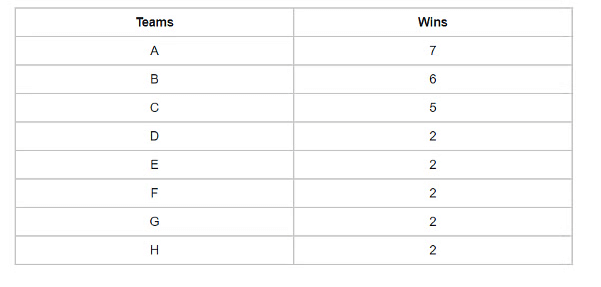
To maximize the number of wins for the top three teams, the top team (A) wins all the matches, i.e. 7, then the next team (B) will win 6 matches (the only match the second team lost is to the top team) and the third team (C) will win 5 matches. Summing up the wins for top 3 teams, it comes out to be 18 with only 10 wins remaining for the rest of the 5 teams. So, we distribute each team with 2 wins. The team D will qualify with the help of net run rate or some other parameter. In case of a football tournament, the parameter can be the number of goals. Similarly, this parameter will vary with different games. The answer for M1 is 2 in this case.
Maximum Number of Wins even after which a Team can go out of the Tournament
- Like the previous case, we will consider a scenario where no matches end in a draw. The team that does not qualify will be the fifth team (E). All the top 5 teams will have the same number of wins, but the fifth team will miss out due to net run rate (or another tie-breaking parameter).
- First, the top three teams win all their matches against the bottom three teams. That accounts for 15 wins out of a total of 28. This leaves us with 13 wins to distribute.
- Now, each of the top 5 teams plays four matches against the other four. The total number of matches among the top 5 teams is 5C2 = 10. These 10 matches account for 10 wins. If we distribute these wins evenly, each of the top 5 teams gets 2 wins from these head-to-head games.
- Thus, each of the top 5 teams has 3 wins from beating the bottom three teams and 2 wins from among themselves, making it 5 wins each. Due to net run rate, team E drops out despite having the same number of wins.
- Another way to approach this is by assigning minimum wins from the bottom up. Let’s say team H loses all its matches, ending with 0 wins. Team G beats only H, ending with 1 win. Team I beats both H and G, giving it 2 wins. That accounts for 3 wins out of 28, leaving 25 wins to be distributed among the top 5 teams.
- We can now evenly distribute these 25 wins among the top 5 teams. If the division isn’t equal, assign the extra wins to the top-ranked team, then to the second team, and so on.
Minimum wins to ensure a Place in Play-Offs
- From the previous case, we can see that even with 5 wins, a team can miss out on a place in the play-offs. Therefore, to secure qualification, a team must win at least 6 matches (in the context of the scenario we're discussing).
- This case differs from the first one, where 5 wins leading to elimination was just one possible outcome. In contrast, the third case provides a guaranteed path to the play-offs, making it a more reliable benchmark.
2. Knockout Tournaments
- A knockout tournament is another commonly asked structure in the CAT exam. In this format, every game eliminates one player—the loser—so only the winner moves forward. This means the eventual champion must win all their matches.
- Tennis is a frequently cited example when discussing knockout formats in CAT questions, making it a useful reference for practice.
The total number of players are generally 2k, where k is a natural number. There are cases when the number of players is not 2k. We will discuss them later. First, we will discuss the cases where we have 2k players. Few things to remember regarding such tournaments:
- Total number of matches = Total number of players – 1.
- Knockout tournaments will generally have seeded (ranked) players.
- Knockout tournaments will not have a tie. There will always be a tiebreaker. It is a knockout after all.
- Upset means a lower-seeded player defeats upper seeded player.
- The total number of rounds is k (from 2k) and kth round is the final round.
- First seeded player (rank 1) will play with last seeded player, rank 2 with the second last seeded and so on.
For instance, in a knockout tournament with 8 players, total matches = 8 - 1 = 7. Round 1 has 4 matches (8 players), Round 2 has 2 matches (4 players), Round 3 has 1 match (final). If Player 1 (seed 1) beats Player 8, they advance, while the loser is eliminated.
Question: Let us take a case of 64 players. We know 26 is 64; therefore, there are 6 rounds. If player seeded 2 reached semi-final, then who could be his likely opponent.
Ans:
Approach: First, we need to understand the number of possibilities. The semi-final is the fifth round, which means that any player reaching the fifth round must have already won four matches.
Let’s assume that the i-th seeded player is the second seed’s opponent. To determine potential opponents in each round, we will expand the value of i by subtracting 2 (for the second seed) from the total number of players in that round plus 1. To simplify, we can create a chart that outlines the possible opponents the second-seeded player could have faced in each round.
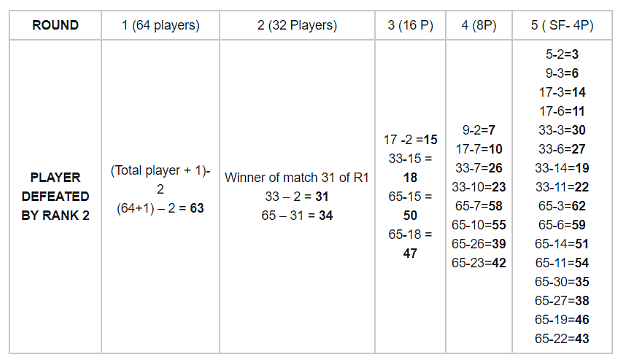 The bold number in the tables indicates the possibilities of opponents for the second seeded player in that particular round.
The bold number in the tables indicates the possibilities of opponents for the second seeded player in that particular round.
Semi-final has 16 possibilities or 2(round number -1) possibilities. The method is simple as we can see from the table. We subtract the rank from total number of players in that round +1. Next, the value obtained is minus from total players + 1 in previous round (say in R3, the previous round is R2).
- All the rank values obtained after this step is subtracted from the total players + 1 of the round before R2 (i.e. R1) and so on.
In case of no upsets, we will always take the lowest rank from the set of values, or just subtract from total players + 1 for that particular round. - In case of upset, you should try to find out the rank of the player, the higher seeded player would have played against.
If the number of player is not 2k, where k is a natural number, then there will be walkovers. - Remember, at the end we need a final match and it will require just two players. So, at some point in the tournament we will encounter an odd number which will make it difficult to have matches for all the players.
- Suppose, at some point there are 25 players, then we can have only 12 matches and player will get a walkover to next round or he/she might be knocked out at random.
- In any case, we can only have even number of players at every round. In such cases to find out the number of rounds (say k rounds), 2k-1< N < 2k, where N is the number of players at the start of the tournament.
- For example, if we have 70 players, then the number of rounds will be 7 as 26 < 70 < 27. The condition for walkover or bye could be either random or based on rank of the player; it will be mentioned in the question.
Let us understand this with the help of an example:
Example: 75 players participated in a tennis tournament, where every match is a knockout. If there are odd number of players in any round, then the top seeded player in that round gets a walkover to next round.
(i) If there are no walkovers from round 2 onwards, then how many matches are played in round 1.
(ii) If top seeded players of quarterfinal and semi-final are defeated in the upsets, what is the sum of the ranks of the players reaching the finals? Assume only one walkover per round.
Ans:
- Since round 2 onwards there are no walkovers, we need to make number of players 2k in round 2 itself. The 2k nearest to 75 and smaller than 75 is 64. Hence, we need to have 64 players in round 2.
- 75-64 = 11 players are knocked out in round 1, which means 11 matches have been played in round 1. This also means that 75-22 (11 matches between 22 players) = 53 players were granted a walkover to round 2.
- Since the only two upsets mentioned occur in the quarterfinal and the semifinal, the top-seeded player (Rank 1) must have reached the quarterfinal. This top seed is then defeated in the quarterfinal match. As only one walkover is allowed per round and is always given to the top-seeded player of that round, Rank 1 remains the top seed up to the quarterfinal. To proceed further, we need to determine the number of players in each round.

- We observe that a walkover is granted in the quarterfinal. Since Rank 1 is the highest-seeded player and eligible for the walkover, the next top-seeded player competing will be Rank 2. Rank 2 is then defeated in the quarterfinal. In the semifinal, a walkover is granted again, and it will go to the highest remaining seed, which is once again Rank 1.
- Hence, Rank 1 reaches the final. Rank 2 is defeated in the quarterfinal, and since no other upsets are mentioned in the earlier rounds, Rank 2 must have played against Rank 5 in the quarterfinal, while Rank 3 played against Rank 4 (with Rank 4 defeating Rank 3, as top-seeded players are supposed to lose in the quarterfinal and semifinal). In the semifinal, Rank 5 defeats Rank 4. The final match is between Rank 1 and Rank 5. Therefore, the sum of the ranks of the finalists is 6.
- We see that the question asked is tricky and can be confusing at times. One needs to be clear with the terms used and have a understanding of the structure in the question. Otherwise, you might spend unnecessary time figuring out the structure itself.
- We talked about the two structures. Now, we will quickly discuss the win-loss table. The table is based mostly on either of the two structures, sometimes with little more information.
- The following table shows the points scored by the teams in a cricket tournament. A win is awarded 2 points, and in the case of a tie, each team receives 1 point. Each team plays against every other team exactly once in the tournament. Only two teams have the same number of points. Two pairs of teams have the same number of wins, and one pair has the same number of losses. Some of the entries in the table are missing.
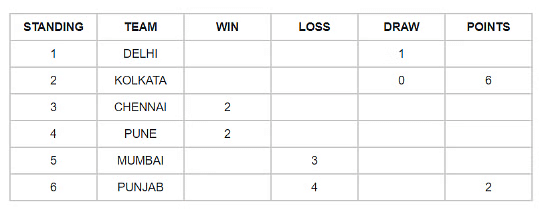
This table looks difficult to fill and involves a lot of iterations.We know the following things:
- 6 teams, total matches are 6C2 = 15.
- Total wins + (total draw/2) = 15
- Each team played 5 matches
EduRev Tip: Start with teams having fixed points or matches (e.g., Punjab: 2 points, 4 losses). Use total matches (N choose 2) and total wins to fill gaps systematically, checking conditions like same points or wins at each step.
From the table, we observe the following:
Punjab has 2 points. Since 2 points can only be earned through 1 win or 2 ties, and Punjab has already lost 4 matches, the only possibility is that Punjab won 1 match, lost 4, and had no draws (1 W, 4 L, 0 D).
Kolkata has 6 points and no draws. This means Kolkata won 3 matches and lost 2 (3 W, 2 L, 0 D).
We also know that two teams have the same score. The three possible pairs of teams with the same points are:
Kolkata and Chennai
Chennai and Pune
Pune and Mumbai
Why are these the possible pairs?
Delhi has 1 draw, meaning it will have an odd number of points.
Mumbai and Punjab cannot have the same number of points because Punjab has 2 points, which does not match Mumbai's total.
Thus, the possible pairs with the same points are limited to the mentioned options.
If Pune and Mumbai have the same points:
- Mumbai would have 2 wins and 4 points (2 W, 3 L, 0 D).
Pune would also have 2 wins, 3 losses, and 0 draws (2 W, 3 L, 0 D), for a total of 4 points.
This leaves Chennai with 5 points, which implies 2 wins and at least 1 draw (2 W, 2 L, 1 D).
Chennai’s total points would then be 2 W, 2 L, 1 D, which gives us 5 points.
The total number of wins so far is:
Kolkata (3 W)
Chennai (2 W)
Pune (2 W)
Mumbai (2 W)
Punjab (1 W)
This gives us a total of 10 wins. Adding 1 draw match and 4 remaining wins, all 4 remaining wins would be accounted for by Delhi.
However, we missed the condition that two pairs have the same number of wins. This means our assumption about Pune and Mumbai having the same points is incorrect.
If Chennai and Pune have the same points:
Chennai would have 2 wins, 3 losses, and 0 draws (2 W, 3 L, 0 D).
Pune would also have 2 wins, 3 losses, and 0 draws (2 W, 3 L, 0 D).
Mumbai would have 1 win, 3 losses, and 1 draw (1 W, 3 L, 1 D).
This leads to Delhi having 5 wins and 1 draw, which is impossible, as we cannot have 5 wins with only 6 possible teams.
Thus, this assumption doesn't work either.
If Kolkata and Chennai have the same points:
Kolkata would have 3 wins and 2 losses (3 W, 2 L, 0 D).
Chennai would have 2 wins, 1 loss, and 2 draws (2 W, 1 L, 2 D).
Pune would have 2 wins, 3 losses, and 0 draws (2 W, 3 L, 0 D).
Mumbai would have 1 win, 3 losses, and 1 draw (1 W, 3 L, 1 D).
Delhi would have 4 wins, 0 losses, and 1 draw (4 W, 0 L, 1 D).
Now, we have:
Two teams (Kolkata and Chennai) with the same points (5 points each).
Two pairs with the same number of wins (Kolkata and Chennai each have 2 wins).
One pair with the same number of losses (Kolkata and Chennai both have 2 losses).
This setup satisfies all the conditions:
- Two teams have the same points.
Two pairs have the same number of wins.
One pair has the same number of losses.
In conclusion, the correct configuration is:
Kolkata: 3 W, 2 L, 0 D
Chennai: 2 W, 1 L, 2 D
Pune: 2 W, 3 L, 0 D
Mumbai: 1 W, 3 L, 1 D
Delhi: 4 W, 0 L, 1 D
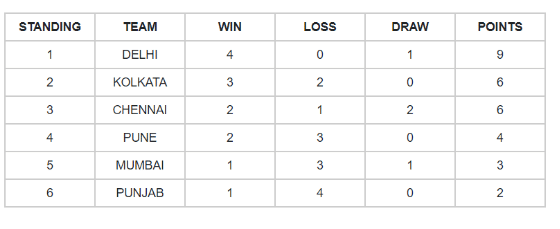
The win-loss table can be time-consuming, so it’s important to practice it regularly. Games like race events can be solved using linear arrangement concepts. Keep solving more tables to become familiar with the key details and patterns in them.
Example: In the table below is the listing of Teams, seeded from highest (#1) to lowest (#16), who are due to play in an Association of Cricket tournament. This tournament has three knockout rounds before the final, i.e., first round, Quarter-finals, and semi-finals. In the first round, the highest seeded team plays the lowest seeded team (seed#16) which is designated match No. 1 of first round; the 2nd seeded team plays with the 15th seeded team which is designated match No. 2 of the first round, and so on. Thus, for instance, match No. 8 of first round is to be played between 8th seeded team and the 9th seeded team. In the second round, the winner of match No. 1 of first round plays the winner of match No. 8 of first round and is designated match No. 1 of second round. Similarly, the winner of match No. 2 of first round plays the winner of match No. 7 of first round, and is designated match No. 2 of second round. Thus, for instance, match No. 4 of the second round is to be played between the winner of match No. 4 of first round and the winner of match No. 5 of first round. The same pattern is followed for later rounds as well.
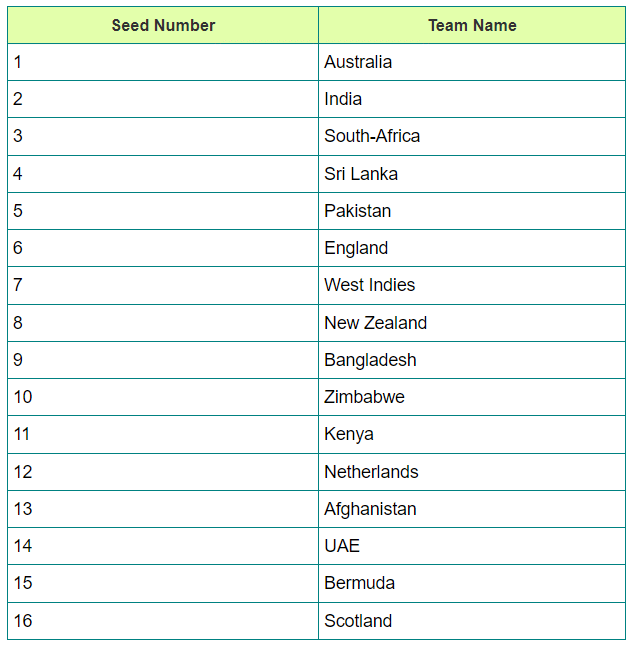 i) If there are no upsets in the first round, and only match Nos. 2, 3, and 4 of the second round result in upsets, then who would meet Pakistan in semi finals, in case Pakistan reaches semi finals?
i) If there are no upsets in the first round, and only match Nos. 2, 3, and 4 of the second round result in upsets, then who would meet Pakistan in semi finals, in case Pakistan reaches semi finals?
a) India
b) England
c) Australia
d) Didn’t reach in semi finals
Ans: c) Australia
In round 1 there were no upset, but in round two upsets in match No. 2, 3 and 4 (i.e. match between Seed No. 2 and 7, 3 and 6, 4 and 5 respectively).
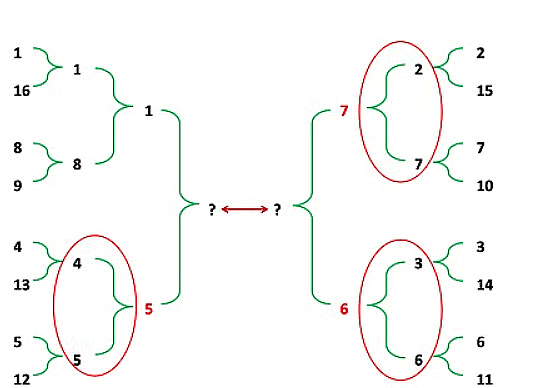 So, Pakistan (i.e. Seed no. 5) will face Australia (i.e. Seed no. 1) in semi finals.
So, Pakistan (i.e. Seed no. 5) will face Australia (i.e. Seed no. 1) in semi finals.
So, answer is Australia.
ii) If South-Africa and Sri-Lanka lose in the first round, while Bangladesh and India make it to the semifinals, then who would play with Australia in the second round, in the event Australia reaches second round?
a) Bangladesh
b) Scotland
c) New Zealand
d) India
Ans: a) Bangladesh
According to given terms, Seed No. 2 (India) and 9 (Bangladesh) reaches semi-finals. So, they must have won all the preceding rounds.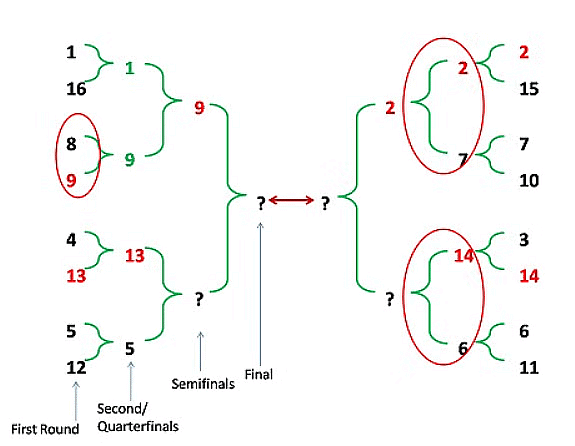 So, from above diagram we can see that Bangladesh played against Australia in second round.
So, from above diagram we can see that Bangladesh played against Australia in second round.
iii) If, in the first round, all even numbered matches (and none of the odd numbered ones) result in upsets, and there are no upsets in the second round, then which team facing South-Africa in semi-finals?
a) Australia
b) West-Indies
c) Bermuda
d) India
Answer: b) West-Indies
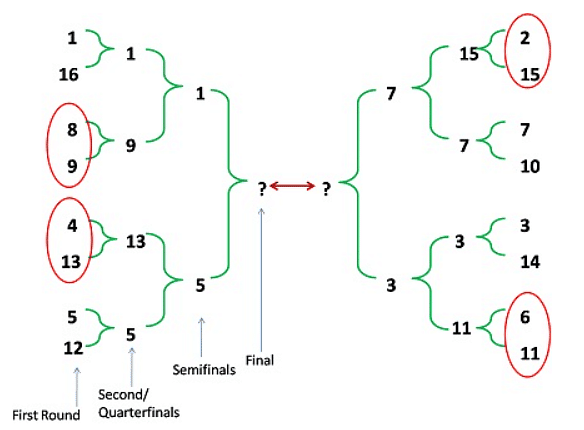
In the diagram, we can see that upsets are in even numbered matches i.e. matched between 2 and 15, 4 and 13, 6 and 11, 8 and 9 respectively.
And there are no upsets in second round.
So, from that in semi-finals South-Africa (Seed no. 3) faces West-Indies.
iv) How many matches are played in this tournament for getting final winner?
a) 32
b) 24
c) 16
d) 15
Ans: d) 15
In knockout tournament, total n - 1 matches are played for getting final winner. Here n=16, so total 16 - 1 = 15 matches are played.
3. Combination or Hybrid Models
Hybrid tournaments blend round-robin and knockout systems to balance fairness, competitiveness, and entertainment. This format ensures teams/players earn progression through consistent performance in the group stage, followed by high-stakes knockout matches.
Structure of Hybrid Tournaments
Group Stage (Round Robin) :
- Teams are divided into groups, playing every other team in their group.
- Example: In the IPL, 10 teams play 14 matches (each team faces 7 opponents twice).
- Key Formula: Total matches in round-robin = 2n(n−1), where n is the number of teams.
Knockout Stage (Playoffs) :
- Top teams from each group advance to a knockout bracket.
- Example: IPL playoffs include Qualifiers (e.g., Top 4 teams enter a double-elimination bracket).
- Qualifier 1: 1st vs. 2nd place (winner advances directly to the final).
- Eliminator: 3rd vs. 4th place (loser is eliminated, winner advances to Qualifier 2).
- Qualifier 2: Winner of Qualifier 1 vs. Winner of Eliminator.
Key Points
- If your answer is G, H, and I, and the options are G and H, H and I, G and I, and "None of the above," you should select "None of the above."
- If M lost to N but won against O and P, it means M won against O and P. Similarly, if M lost to N, and N won against O and P, then N won against O and P.
- If it is stated that "M did not win against N," it doesn't necessarily mean N won. In this case, a draw or tie is also a possible outcome.
- Standings refer to the positions (similar to rankings in a points table) of a team after a round or part of the tournament.
- If you spend more than 5 minutes reading and drawing a possible table but still can't get clean data, it’s best to leave the question and move on to the next one. Sometimes, overthinking a data point can cause you to get stuck. Take a break, and approach these questions with a fresh perspective.
- Knock-out matches are those in which the losing team exits the tournament. In a knock-out tournament, if there are n teams or players, the total number of matches played is n-1. This logic also holds true in a "Bye" system. For example, if there are 10 teams in a knock-out tournament, there will be 9 (i.e., 10 - 1) matches played.
- Round-robin tournaments require each team to play a fixed number of matches before being eliminated or winning the tournament.
- In this format, each team plays against every other team exactly once. In a round-robin tournament, the total number of matches is given by nC2. For example, if there are 10 teams in a round-robin tournament, the total number of matches would be nC2 = 10C2 = 45.
Summary
- Round-Robin: Total matches = N choose 2; wins + (draws/2) = matches.
- Knockout: Total matches = N - 1; each round halves the players.
- Points Strategy: For minimum points, distribute from top to bottom; for maximum, bottom to top.
- Tip: Use diagrams for knockout tournaments and tables for point distribution to visualise scenarios.
Practice more problems to master these concepts efficiently!
FAQs on Games and Tournaments: Solved Examples - CAT
| 1. What are some popular games often featured in tournaments? |  |
| 2. How can someone participate in a gaming tournament? |  |
| 3. What are the different formats of gaming tournaments? |  |
| 4. What are the benefits of participating in gaming tournaments? |  |
| 5. How can someone stay updated on upcoming gaming tournaments? |  |




















